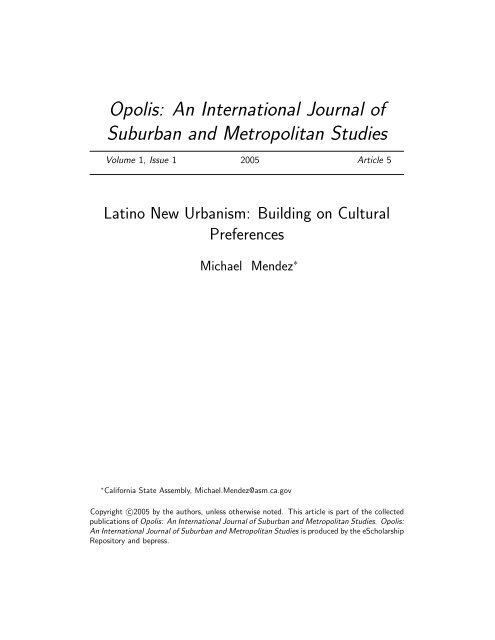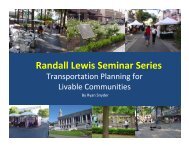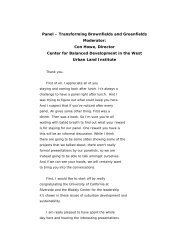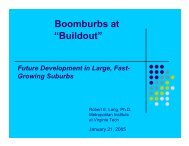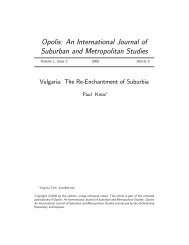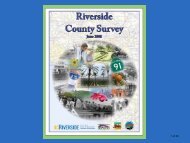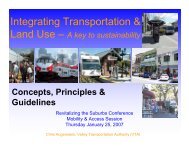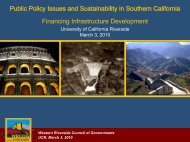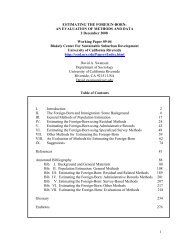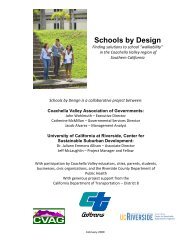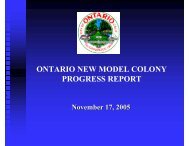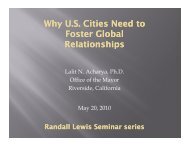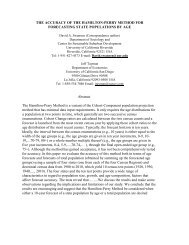Latino New Urbanism: Building on Cultural Preferences - Center for ...
Latino New Urbanism: Building on Cultural Preferences - Center for ...
Latino New Urbanism: Building on Cultural Preferences - Center for ...
You also want an ePaper? Increase the reach of your titles
YUMPU automatically turns print PDFs into web optimized ePapers that Google loves.
Opolis: An Internati<strong>on</strong>al Journal of<br />
Suburban and Metropolitan Studies<br />
Volume 1, Issue 1 2005 Article 5<br />
<str<strong>on</strong>g>Latino</str<strong>on</strong>g> <str<strong>on</strong>g>New</str<strong>on</strong>g> <str<strong>on</strong>g>Urbanism</str<strong>on</strong>g>: <str<strong>on</strong>g>Building</str<strong>on</strong>g> <strong>on</strong> <strong>Cultural</strong><br />
<strong>Preferences</strong><br />
Michael Mendez ∗<br />
∗ Cali<strong>for</strong>nia State Assembly, Michael.Mendez@asm.ca.gov<br />
Copyright c○2005 by the authors, unless otherwise noted. This article is part of the collected<br />
publicati<strong>on</strong>s of Opolis: An Internati<strong>on</strong>al Journal of Suburban and Metropolitan Studies. Opolis:<br />
An Internati<strong>on</strong>al Journal of Suburban and Metropolitan Studies is produced by the eScholarship<br />
Repository and bepress.
Abstract<br />
With characteristics differing from majority households, <str<strong>on</strong>g>Latino</str<strong>on</strong>g> growth is occurring at a<br />
time when Cali<strong>for</strong>nia is torn between several urban development models—developing compact<br />
cities, preserving the envir<strong>on</strong>ment, or increasing urban sprawl and slums. The central argument<br />
of this article is that <str<strong>on</strong>g>Latino</str<strong>on</strong>g>s’ cultural inclinati<strong>on</strong> to a lifestyle supportive of compact<br />
cities provides policymakers with a sustainable alternative that possesses a built-in c<strong>on</strong>sumer<br />
base. The development and advancement of compact cities in Cali<strong>for</strong>nia may be dependent<br />
<strong>on</strong> the ability of policy makers to sustain and support the <str<strong>on</strong>g>Latino</str<strong>on</strong>g> lifestyle.<br />
This article addresses city development policies that pressure <str<strong>on</strong>g>Latino</str<strong>on</strong>g>s to assimilate to the<br />
established US noti<strong>on</strong> of appropriate space use and how they undercut the ec<strong>on</strong>omic, social,<br />
and envir<strong>on</strong>mental benefits inherent in the <str<strong>on</strong>g>Latino</str<strong>on</strong>g> lifestyle. The article also illustrates the<br />
key role <str<strong>on</strong>g>Latino</str<strong>on</strong>g>s play in adapting and trans<strong>for</strong>ming existing neighborhoods to promote <str<strong>on</strong>g>New</str<strong>on</strong>g><br />
Urbanist-type landscapes.<br />
Acknowledgements: Michael Mendez is Senior Legislative Assistant to Cali<strong>for</strong>nia Assemblymember<br />
Cindy M<strong>on</strong>tañez. This article was drawn from his Master’s Thesis at the Massachusetts<br />
Institute of Technology.<br />
Keywords: <str<strong>on</strong>g>Latino</str<strong>on</strong>g>, <str<strong>on</strong>g>New</str<strong>on</strong>g> <str<strong>on</strong>g>Urbanism</str<strong>on</strong>g>, Hispanic, Minority Sprawl<br />
Suggested Citati<strong>on</strong>:<br />
Michael Mendez (2005) “<str<strong>on</strong>g>Latino</str<strong>on</strong>g> <str<strong>on</strong>g>New</str<strong>on</strong>g> <str<strong>on</strong>g>Urbanism</str<strong>on</strong>g>: <str<strong>on</strong>g>Building</str<strong>on</strong>g> <strong>on</strong> <strong>Cultural</strong> <strong>Preferences</strong>”, Opolis:<br />
An Internati<strong>on</strong>al Journal of Suburban and Metropolitan Studies: Vol. 1: No. 1, Article 5.<br />
http://repositories.cdlib.org/cssd/opolis/vol1/iss1/art5
<str<strong>on</strong>g>Latino</str<strong>on</strong>g> <str<strong>on</strong>g>New</str<strong>on</strong>g> <str<strong>on</strong>g>Urbanism</str<strong>on</strong>g>:<br />
<str<strong>on</strong>g>Building</str<strong>on</strong>g> <strong>on</strong> <strong>Cultural</strong> <strong>Preferences</strong><br />
Michael Mendez<br />
State of Cali<strong>for</strong>nia<br />
Abstract<br />
Opolis Vol. 1, No. 1: Winter 2005, pp. 33-48<br />
© 2004. All Rights Reserved.<br />
With characteristics differing from majority households, <str<strong>on</strong>g>Latino</str<strong>on</strong>g> growth is<br />
occurring at a time when Cali<strong>for</strong>nia is torn between several urban development<br />
models—developing compact cities, preserving the envir<strong>on</strong>ment, or increasing<br />
urban sprawl and slums. The central argument of this article is that <str<strong>on</strong>g>Latino</str<strong>on</strong>g>s’<br />
cultural inclinati<strong>on</strong> to a lifestyle supportive of compact cities provides policy<br />
makers with a sustainable alternative that possesses a built-in c<strong>on</strong>sumer base.<br />
The development and advancement of compact cities in Cali<strong>for</strong>nia may be<br />
dependent <strong>on</strong> the ability of policy makers to sustain and support the <str<strong>on</strong>g>Latino</str<strong>on</strong>g><br />
lifestyle.<br />
This article addresses city development policies that pressure <str<strong>on</strong>g>Latino</str<strong>on</strong>g>s to<br />
assimilate to the established US noti<strong>on</strong> of appropriate space use and how they<br />
undercut the ec<strong>on</strong>omic, social, and envir<strong>on</strong>mental benefits inherent in the <str<strong>on</strong>g>Latino</str<strong>on</strong>g><br />
lifestyle. The article also illustrates the key role <str<strong>on</strong>g>Latino</str<strong>on</strong>g>s play in adapting and<br />
trans<strong>for</strong>ming existing neighborhoods to promote <str<strong>on</strong>g>New</str<strong>on</strong>g> Urbanist-type landscapes.<br />
Key words: <str<strong>on</strong>g>Latino</str<strong>on</strong>g>, <str<strong>on</strong>g>New</str<strong>on</strong>g> <str<strong>on</strong>g>Urbanism</str<strong>on</strong>g>, Hispanic, Minority Sprawl<br />
Synthesis of the <str<strong>on</strong>g>Latino</str<strong>on</strong>g> Lifestyle and<br />
the <str<strong>on</strong>g>New</str<strong>on</strong>g> <str<strong>on</strong>g>Urbanism</str<strong>on</strong>g><br />
For generati<strong>on</strong>s, <str<strong>on</strong>g>Latino</str<strong>on</strong>g> families have<br />
combined traditi<strong>on</strong>al values with<br />
modern <strong>on</strong>es. Present-day Chicano- or<br />
<str<strong>on</strong>g>Latino</str<strong>on</strong>g>-American families are a fusi<strong>on</strong><br />
of the social and cultural heritages of<br />
both Anglo and Latin America. That<br />
combinati<strong>on</strong> is c<strong>on</strong>tinually being<br />
redefined, creating something different<br />
from either the traditi<strong>on</strong>al or Anglo<br />
<strong>for</strong>ms (Pader 1994).<br />
33<br />
The fusi<strong>on</strong> of Anglo and Latin cultures<br />
is compatible not <strong>on</strong>ly with cities of<br />
high-density housing and efficient<br />
transportati<strong>on</strong> systems, but also with<br />
<str<strong>on</strong>g>New</str<strong>on</strong>g> Urbanist and Smart Growth<br />
communities. The <str<strong>on</strong>g>Latino</str<strong>on</strong>g> lifestyle<br />
represents an untapped resource that<br />
could enable the development of more<br />
sustainable communities throughout<br />
Cali<strong>for</strong>nia. <str<strong>on</strong>g>Latino</str<strong>on</strong>g>s’ cultural inclinati<strong>on</strong>s
34 Opolis | Volume 1, Number 1: Winter 2005<br />
<strong>for</strong> social interacti<strong>on</strong> and their adaptive<br />
energies have created a de facto<br />
envir<strong>on</strong>ment that already supports<br />
compact city and <str<strong>on</strong>g>New</str<strong>on</strong>g> Urbanist<br />
lifestyles.<br />
<str<strong>on</strong>g>New</str<strong>on</strong>g> <str<strong>on</strong>g>Urbanism</str<strong>on</strong>g>, similar to the compact<br />
city, is an attempt to re<strong>for</strong>m the<br />
sprawling pattern of suburban growth.<br />
Through a wide-ranging approach of<br />
architectural planning and design, <str<strong>on</strong>g>New</str<strong>on</strong>g><br />
<str<strong>on</strong>g>Urbanism</str<strong>on</strong>g> seeks to replicate cities such<br />
as Charlest<strong>on</strong>, South Carolina, and Old<br />
Town Alexandria, Virginia. <str<strong>on</strong>g>New</str<strong>on</strong>g><br />
<str<strong>on</strong>g>Urbanism</str<strong>on</strong>g> favors residential<br />
development that includes small lots,<br />
short housing setbacks, alleys, fr<strong>on</strong>t<br />
porches, compact walkable<br />
neighborhoods with abundant public<br />
spaces and parks, and a mix of land<br />
uses. Additi<strong>on</strong>ally, through the mix of<br />
diverse housing styles, land uses, and<br />
accessibility to parks, <str<strong>on</strong>g>New</str<strong>on</strong>g> Urbanist<br />
developments seek to c<strong>on</strong>struct a<br />
place that promotes social interacti<strong>on</strong><br />
and a str<strong>on</strong>g sense of community (Hall<br />
and Porterfield 2001).<br />
Such <str<strong>on</strong>g>New</str<strong>on</strong>g> Urbanist principles are<br />
already present in many established<br />
Cali<strong>for</strong>nia <str<strong>on</strong>g>Latino</str<strong>on</strong>g> communities. <str<strong>on</strong>g>Latino</str<strong>on</strong>g>s<br />
have c<strong>on</strong>tinually used adaptive<br />
methods to trans<strong>for</strong>m their<br />
communities to better suit their needs<br />
and to promote social interacti<strong>on</strong>. This<br />
is most apparent through their adaptive<br />
reuse of homes, parks, and public<br />
spaces. The cultural predilecti<strong>on</strong>s have<br />
created a Latinized model of <str<strong>on</strong>g>New</str<strong>on</strong>g><br />
Urbanist communities.<br />
<str<strong>on</strong>g>Latino</str<strong>on</strong>g> Assimilati<strong>on</strong> and Implicati<strong>on</strong>s<br />
<strong>for</strong> Planning<br />
<str<strong>on</strong>g>Latino</str<strong>on</strong>g>s eventually will be the majority<br />
populati<strong>on</strong> in Cali<strong>for</strong>nia, and their<br />
characteristics and lifestyle choices will<br />
have a direct effect <strong>on</strong> state planning<br />
functi<strong>on</strong>s and land-use patterns.<br />
Accordingly, this implies that policy<br />
makers should look bey<strong>on</strong>d their<br />
prejudices and perceived c<strong>on</strong>cepti<strong>on</strong>s<br />
of <str<strong>on</strong>g>Latino</str<strong>on</strong>g> characteristics and think of<br />
the desirable and beneficial outcomes<br />
of incorporating them into policy. It is<br />
the role of policy makers to enact<br />
policies that reflect the needs of<br />
residents within a jurisdicti<strong>on</strong> and to<br />
deter the use of policies that divide<br />
communities al<strong>on</strong>g racial or ethnic<br />
lines. There<strong>for</strong>e, as the compositi<strong>on</strong> of<br />
residents in Cali<strong>for</strong>nia changes,<br />
existing and proposed policies should<br />
also change.<br />
In a state as diverse as Cali<strong>for</strong>nia,<br />
multiculturalism ideally should enable<br />
<str<strong>on</strong>g>Latino</str<strong>on</strong>g>s and n<strong>on</strong>-<str<strong>on</strong>g>Latino</str<strong>on</strong>g>s to pursue<br />
lifestyles that support a variety of<br />
housing developments and styles.<br />
Multiculturalism would argue that those<br />
who prefer to live in compact cities<br />
should be able to do so, while those<br />
who prefer a lower density should be<br />
allowed to pursue a different opti<strong>on</strong>...it<br />
brings into focus a fundamental<br />
philosophical questi<strong>on</strong> that all planners<br />
and policy makers must c<strong>on</strong>fr<strong>on</strong>t: Am I<br />
advocating a pluralist or an<br />
assimilati<strong>on</strong>ist city (Myers 2001)?<br />
Despite the multicultural nature of<br />
Cali<strong>for</strong>nia, it remains uncertain whether<br />
<str<strong>on</strong>g>Latino</str<strong>on</strong>g>s and others who favor compact<br />
city lifestyles will be allowed to pursue<br />
them. The development of a more<br />
sustainable, compact Cali<strong>for</strong>nia is<br />
largely dependent <strong>on</strong> enacting policies<br />
that are representative of the<br />
preferences and needs of current and<br />
future populati<strong>on</strong> groups.
<str<strong>on</strong>g>Latino</str<strong>on</strong>g> Evoluti<strong>on</strong> of American Homes<br />
The adaptive reuse of homes is visible<br />
throughout Cali<strong>for</strong>nia, but it is most<br />
evident in East Los Angeles, where a<br />
distinct spatial <strong>for</strong>m represents the<br />
cultural, ec<strong>on</strong>omic and regi<strong>on</strong>al<br />
soluti<strong>on</strong>s residents have developed to<br />
meet their criteria <strong>for</strong> the built<br />
envir<strong>on</strong>ment. In East Los Angeles, as<br />
James Rojas (1991) has described, the<br />
residents have developed a working<br />
peoples’ manipulati<strong>on</strong> and adaptati<strong>on</strong><br />
of the envir<strong>on</strong>ment, where Mexican-<br />
Americans live in small wooden<br />
houses, built by Anglos, that have<br />
evolved to what he calls the “East Los<br />
Angeles Vernacular.”<br />
In East Los Angeles, the urban<br />
landscape is a fusi<strong>on</strong> of several<br />
architectural and cultural styles that are<br />
neither entirely Mexican, nor Spanish,<br />
nor Anglo-American. According to<br />
Rojas, the trans<strong>for</strong>mati<strong>on</strong> of homes<br />
typically follows three stages:<br />
1. Minimal changes in which the<br />
residents use what they<br />
acquire;<br />
2. Minor changes, such as the<br />
additi<strong>on</strong> of paint, stucco, and<br />
chain-link fences;<br />
Mendez: <str<strong>on</strong>g>Latino</str<strong>on</strong>g> <str<strong>on</strong>g>New</str<strong>on</strong>g> <str<strong>on</strong>g>Urbanism</str<strong>on</strong>g><br />
35<br />
3. Major changes (investment in<br />
structural changes) such as<br />
adding or enlarging the fr<strong>on</strong>t<br />
porch, changes in architectural<br />
styles, baroque-style wrought<br />
ir<strong>on</strong> fences, fountains, and<br />
other amenities.<br />
Furthermore, in East Los Angeles the<br />
vernacular coincides with what Daniel<br />
Arreola describes as the Mexican-<br />
American housescape—a detached,<br />
single-family dwelling and its<br />
immediate surroundings in the urban<br />
barrio of the Southwest. The<br />
housescape is a complex of elements<br />
that includes the fr<strong>on</strong>t yard up to the<br />
fence or wall (Arreola 1988).<br />
Moreover, the introverted Americanstyle<br />
homes are trans<strong>for</strong>med to<br />
extroverted, Mexicanized or Latinized<br />
homes. The <str<strong>on</strong>g>Latino</str<strong>on</strong>g> house expands to<br />
all four comers of the lot, allowing <strong>for</strong> a<br />
more efficient, maximum use of space.<br />
The evoluti<strong>on</strong> of American homes in<br />
East Los Angeles and other <str<strong>on</strong>g>Latino</str<strong>on</strong>g><br />
communities in the Southwest<br />
presumably derives from attempts to<br />
emulate the traditi<strong>on</strong>al Mexican<br />
courtyard-style home, built to the street<br />
line and designed with a patio or<br />
courtyard in the center or fr<strong>on</strong>t of the
36 Opolis | Volume 1, Number 1: Winter 2005<br />
house (Rojas 1991). The Mexican<br />
home, as explained in Ellen Pader’s<br />
research, is not designed <strong>for</strong> privacy,<br />
but to maximize social interacti<strong>on</strong><br />
am<strong>on</strong>g household members (Pader<br />
1994).<br />
Driveways and porches are also<br />
important elements of the housescape<br />
in <str<strong>on</strong>g>Latino</str<strong>on</strong>g> communities. In Mexican<br />
courtyard-style homes, patios are used<br />
<strong>for</strong> social functi<strong>on</strong>s. In the United<br />
States, the driveway is used as a<br />
substitute to accommodate parties,<br />
barbecues, and other social festivities.<br />
Porches in the <str<strong>on</strong>g>Latino</str<strong>on</strong>g> housescape,<br />
specifically in East Los Angeles, are<br />
often enlarged and expanded,<br />
rein<strong>for</strong>cing the fr<strong>on</strong>t yard as an integral<br />
spatial locati<strong>on</strong> <strong>for</strong> family and social<br />
interacti<strong>on</strong> (Rojas 1991).<br />
According to Rojas, most porches in<br />
East Los Angeles are modified<br />
architecturally to suit the needs and<br />
preferences of the residents. The<br />
majority were originally c<strong>on</strong>structed in<br />
a Victorian or Cali<strong>for</strong>nia Bungalow<br />
style. Residents have trans<strong>for</strong>med the<br />
wooden banister and column fixtures<br />
to a Mexicanized style, with baroque<br />
wrought ir<strong>on</strong> railings, Spanish arches<br />
and stucco. The evoluti<strong>on</strong> of the fr<strong>on</strong>t<br />
porch creates sociability within the<br />
home and surrounding neighborhood<br />
(Rojas, 1991). The fr<strong>on</strong>t porch in the<br />
East Los Angeles vernacular<br />
corresp<strong>on</strong>ds to the objective of <str<strong>on</strong>g>New</str<strong>on</strong>g>
Urbanist developments, in that the<br />
porch invites neighbors to gather.<br />
In <str<strong>on</strong>g>New</str<strong>on</strong>g> Urbanist developments,<br />
porches are a hub <strong>for</strong> social leisure<br />
activities. According to Daria Price<br />
Bowman (1997), the porch is a neutral<br />
territory that provides a natural link to<br />
the neighborhood. In <str<strong>on</strong>g>New</str<strong>on</strong>g> <str<strong>on</strong>g>Urbanism</str<strong>on</strong>g><br />
and the East Los Angeles vernacular<br />
(coupled with the use of the driveway),<br />
the porch is used to increase living and<br />
entertaining opti<strong>on</strong>s (Bowman 1997).<br />
Latinizati<strong>on</strong> of Parks and Public Space<br />
The appropriati<strong>on</strong> of park spaces to<br />
facilitate social activities provides<br />
another example of how <str<strong>on</strong>g>Latino</str<strong>on</strong>g>s adapt<br />
the built envir<strong>on</strong>ment to meet their<br />
physical and social needs.<br />
There is an obvious carryover from<br />
Latin America to the United States of<br />
the preference <strong>for</strong> parks and plazas to<br />
serve as the core social setting of a<br />
community or city. Academic work has<br />
acknowledged the importance of<br />
plazas and parks (public spaces) <strong>for</strong><br />
Mexicans and Mexican-Americans.<br />
Social historian Charles Flaundrau,<br />
awed by the significance of plazas and<br />
parks in Mexico, wrote<br />
There are city parks and<br />
squares in other countries, but<br />
in n<strong>on</strong>e do they play the same<br />
intimate and important part in<br />
the nati<strong>on</strong>al domestic life that<br />
they do in Mexico ...the Plaza is<br />
in c<strong>on</strong>stant use from morning<br />
until late at night ...by eleven<br />
o’clock the whole town will, at<br />
various hours, have passed<br />
through it, strolled in it, played,<br />
Mendez: <str<strong>on</strong>g>Latino</str<strong>on</strong>g> <str<strong>on</strong>g>New</str<strong>on</strong>g> <str<strong>on</strong>g>Urbanism</str<strong>on</strong>g><br />
sat, rested, or thought in it<br />
(Flaundrau 1964).<br />
37<br />
As a result, the US park serves as<br />
<str<strong>on</strong>g>Latino</str<strong>on</strong>g>s’ primary social space outside<br />
the home. The neighborhood park’s<br />
usefulness <strong>for</strong> social interacti<strong>on</strong> offers<br />
a surrogate <strong>for</strong> the misplaced plaza<br />
and meets the objectives of many <str<strong>on</strong>g>New</str<strong>on</strong>g><br />
Urbanist developments. <str<strong>on</strong>g>New</str<strong>on</strong>g><br />
<str<strong>on</strong>g>Urbanism</str<strong>on</strong>g> attempts to create a greater<br />
sense of community by rethinking the<br />
“public realm,” especially public spaces<br />
and recreati<strong>on</strong>al facilities. The<br />
C<strong>on</strong>gress of the <str<strong>on</strong>g>New</str<strong>on</strong>g> <str<strong>on</strong>g>Urbanism</str<strong>on</strong>g>, the<br />
leading organizati<strong>on</strong> <strong>for</strong> the movement,<br />
believes cities and towns should be<br />
shaped by physically defined and<br />
universally accessible public spaces,<br />
and community instituti<strong>on</strong>s (Fult<strong>on</strong>,<br />
1996).<br />
Extensive survey work <strong>on</strong> park usage<br />
am<strong>on</strong>g different ethnic and racial<br />
groups in four metropolitan Los<br />
Angeles parks shows that <str<strong>on</strong>g>Latino</str<strong>on</strong>g>s are<br />
the most active and frequent users<br />
(Loukaitou-Sideris 1995). The survey<br />
found that <str<strong>on</strong>g>Latino</str<strong>on</strong>g>s at parks were<br />
involved in sociable activities including<br />
parties, picnics, and celebrati<strong>on</strong>s of<br />
birthdays, baptism, and communi<strong>on</strong>s.<br />
Their group behavior involved talking<br />
while sitting or standing, eating,<br />
breaking piñatas, playing sports, and<br />
keeping an eye <strong>on</strong> their children. This<br />
is a great c<strong>on</strong>trast to Anglos, who<br />
primarily participated in mobile, solitary<br />
activities such as jogging, walking,<br />
bicycling, or dog walking. The study<br />
c<strong>on</strong>cluded that Anglos valued the park<br />
more <strong>for</strong> its aesthetic qualities and<br />
natural elements while <str<strong>on</strong>g>Latino</str<strong>on</strong>g>s valued<br />
its opportunities <strong>for</strong> social interacti<strong>on</strong>.<br />
<str<strong>on</strong>g>Latino</str<strong>on</strong>g>s also were more likely than<br />
other racial and ethnic groups to
38 Opolis | Volume 1, Number 1: Winter 2005<br />
actively appropriate the neighborhood<br />
parks. If no soccer fields were present<br />
in the park, players would modify the<br />
space to fit their needs. According to<br />
Robert Garcia of the <strong>Center</strong> <strong>for</strong> Law in<br />
the Public Interest, the discriminati<strong>on</strong><br />
against soccer as an “immigrant sport”<br />
resulted in a shortage of soccer fields<br />
compared to fields <strong>for</strong> baseball and<br />
other sports (Garcia 2002).<br />
<str<strong>on</strong>g>Latino</str<strong>on</strong>g>s, Parks, Housescapes, and<br />
their Implicati<strong>on</strong>s<br />
In sum, <strong>for</strong> the <str<strong>on</strong>g>Latino</str<strong>on</strong>g> culture and<br />
lifestyle, housing, and parks are much<br />
more than buildings and open spaces.<br />
They are vital comp<strong>on</strong>ents of social<br />
and ethnic identity. These spaces<br />
facilitate social interacti<strong>on</strong>s and<br />
activities. As the East Los Angeles<br />
vernacular and park usage statistics<br />
dem<strong>on</strong>strate, the fusi<strong>on</strong> of Anglo and<br />
Latin cultures produces manifestati<strong>on</strong>s<br />
compatible not <strong>on</strong>ly with compact<br />
cities, but also with <str<strong>on</strong>g>New</str<strong>on</strong>g> Urbanist and<br />
smart growth communities.<br />
The <str<strong>on</strong>g>Latino</str<strong>on</strong>g> lifestyle represents an<br />
untapped resource that can facilitate<br />
the development of sustainable<br />
communities throughout Cali<strong>for</strong>nia.<br />
<str<strong>on</strong>g>Latino</str<strong>on</strong>g>s’ cultural preferences <strong>for</strong> social<br />
interacti<strong>on</strong>, their adaptive reuses, and<br />
their lifestyle choices have created a<br />
de facto Latinized versi<strong>on</strong> of <str<strong>on</strong>g>New</str<strong>on</strong>g><br />
<str<strong>on</strong>g>Urbanism</str<strong>on</strong>g> and smart growth<br />
communities. However, the pressure<br />
<strong>for</strong> immigrants and minorities to<br />
assimilate to the dominant US noti<strong>on</strong><br />
of the proper use of domestic and<br />
public spaces limits utilizati<strong>on</strong> of<br />
<str<strong>on</strong>g>Latino</str<strong>on</strong>g>s’ cultural propensity <strong>for</strong> compact<br />
and <str<strong>on</strong>g>New</str<strong>on</strong>g> Urbanist lifestyles.<br />
<str<strong>on</strong>g>Latino</str<strong>on</strong>g> Assimilati<strong>on</strong> and Compact<br />
Lifestyles<br />
Literature <strong>on</strong> immigrant adaptati<strong>on</strong> and<br />
assimilati<strong>on</strong> is based primarily <strong>on</strong> the<br />
assumpti<strong>on</strong> that there is a natural<br />
process in which diverse ethnic groups<br />
develop a comm<strong>on</strong> culture and achieve<br />
equal access to all of the opportunities<br />
society offers. This process c<strong>on</strong>sists of<br />
slowly aband<strong>on</strong>ing old cultural and<br />
behavioral patterns in favor of modern<br />
<strong>on</strong>es. Once it has begun, the literature<br />
argues, this process moves inevitably<br />
and permanently toward assimilati<strong>on</strong>.<br />
Thus, diverse immigrant groups,<br />
particularly those from disadvantaged<br />
backgrounds, are expected to<br />
eventually discard their old ways of life<br />
and to become completely “melted”<br />
into the mainstream through residential<br />
integrati<strong>on</strong> and occupati<strong>on</strong>al<br />
achievement in a series of subsequent<br />
generati<strong>on</strong>s (Hirschman, Kasinitz, and<br />
DeWind 1999).<br />
C<strong>on</strong>sequently, assimilati<strong>on</strong> literature<br />
suggests that immersi<strong>on</strong> into the<br />
dominant society is a voluntary,<br />
ef<strong>for</strong>tless acti<strong>on</strong>. However, <strong>for</strong> many<br />
<str<strong>on</strong>g>Latino</str<strong>on</strong>g> immigrants in Cali<strong>for</strong>nia it is<br />
often a <strong>for</strong>ced process. Cali<strong>for</strong>nia cities<br />
have adopted measures that are direct<br />
assaults <strong>on</strong> <str<strong>on</strong>g>Latino</str<strong>on</strong>g> lifestyle and cultural<br />
behaviors. These measures are<br />
designed to evoke an envir<strong>on</strong>ment that<br />
is inhospitable to the <str<strong>on</strong>g>Latino</str<strong>on</strong>g> propensity<br />
toward a compact city lifestyle.<br />
<str<strong>on</strong>g>Latino</str<strong>on</strong>g>s, particularly recent immigrants,<br />
have brought new life to derelict inner<br />
cities and suburbs in the metropolitan<br />
areas of Cali<strong>for</strong>nia. Their ef<strong>for</strong>ts have<br />
created vibrant <str<strong>on</strong>g>Latino</str<strong>on</strong>g> versi<strong>on</strong>s of <str<strong>on</strong>g>New</str<strong>on</strong>g><br />
Urbanist communities and have<br />
revitalized distressed commercial<br />
districts. However, their c<strong>on</strong>tributi<strong>on</strong>s
are often swept aside by local<br />
governments that choose to invest<br />
large sums of tax dollars <strong>for</strong><br />
redevelopment programs that<br />
encourage displacement of <str<strong>on</strong>g>Latino</str<strong>on</strong>g><br />
residents rather than creating<br />
programs that support their<br />
revitalizati<strong>on</strong> ef<strong>for</strong>ts.<br />
As Urbanist Mike Davis (2000) has<br />
explained, throughout Cali<strong>for</strong>nia there<br />
exists a “third border” that creates a<br />
labyrinth of laws, regulati<strong>on</strong>s, and<br />
prejudices that inhibit, and even<br />
criminalize, <str<strong>on</strong>g>Latino</str<strong>on</strong>g> attempts to develop<br />
vibrant communities:<br />
...the worst enemies include<br />
c<strong>on</strong>venti<strong>on</strong>al z<strong>on</strong>ing and<br />
building codes (abetted by<br />
mortgage lending practices)<br />
that af<strong>for</strong>d every loophole to<br />
developers who airdrop oversized,<br />
“instant-slum” apartment<br />
complexes into <strong>for</strong>merly singlefamily<br />
neighborhoods, but<br />
prevent homeowners<br />
themselves from adding legal<br />
additi<strong>on</strong>s to accommodate<br />
relatives or renters. Although<br />
medium-density infill, with<br />
rental income accruing to<br />
resident homeowners, is<br />
obviously a better soluti<strong>on</strong>,<br />
even ecologically, <strong>for</strong> housing<br />
the rising low-income<br />
populati<strong>on</strong>s in Southwestern<br />
cities, it is hardly ever<br />
accommodated by law or<br />
building practice. As a result,<br />
there is a proliferati<strong>on</strong> of<br />
bootlegged, substandard<br />
garage and basement<br />
c<strong>on</strong>versi<strong>on</strong>s that keep <str<strong>on</strong>g>Latino</str<strong>on</strong>g><br />
homeowners embroiled in<br />
Mendez: <str<strong>on</strong>g>Latino</str<strong>on</strong>g> <str<strong>on</strong>g>New</str<strong>on</strong>g> <str<strong>on</strong>g>Urbanism</str<strong>on</strong>g><br />
costly c<strong>on</strong>flicts with city building<br />
inspectors.<br />
39<br />
Such border tactics have included an<br />
ef<strong>for</strong>t by the city of Santa Ana in<br />
Orange County to amend the squarefootage-per-pers<strong>on</strong><br />
standards <strong>for</strong><br />
residences, asserting that the existing<br />
regulati<strong>on</strong>s promote over-crowding.<br />
However, the court struck down the<br />
proposed change in regulati<strong>on</strong><br />
because existing standards<br />
corresp<strong>on</strong>ded with state regulati<strong>on</strong>s,<br />
while the new <strong>on</strong>es would discriminate<br />
against individuals living in the city,<br />
particularly many <str<strong>on</strong>g>Latino</str<strong>on</strong>g> families, who<br />
would not be allowed to live legally in<br />
their current homes 1<br />
Similarly, the City of Anaheim, also in<br />
Orange County, attempted to bar<br />
Gigante, a <str<strong>on</strong>g>Latino</str<strong>on</strong>g>-oriented supermarket,<br />
from a mall the city wanted to<br />
redevelop, claiming the store was “too<br />
Mexican <strong>for</strong> the surroundings” (Yoshino<br />
2002a). According to the 2000 US<br />
Census, the Anaheim census tract<br />
where Gigante wanted to open had a<br />
populati<strong>on</strong> that was more than 60<br />
percent <str<strong>on</strong>g>Latino</str<strong>on</strong>g>. The city warned the<br />
mall’s owners that Anaheim could<br />
withdraw a city subsidy because<br />
Gigante was too specialized. A city<br />
letter said the supermarket “does not<br />
cater to the public at large...product<br />
selecti<strong>on</strong> is catered primarily to the<br />
Hispanic market...store signage and<br />
music are predominantly in Spanish.”<br />
The city urged the mall owners to seek<br />
more mainstream grocery store<br />
tenants (Yoshino 2002a). Despite the<br />
city’s objecti<strong>on</strong>s, Gigante was able to<br />
sign a lease at the mall. However, the<br />
Anaheim Planning Commissi<strong>on</strong><br />
unanimously rejected the company’s<br />
1 Brazen v. City of Santa Ana, 1992, Cali<strong>for</strong>nia Superior Court No. 659206.
40 Opolis | Volume 1, Number 1: Winter 2005<br />
applicati<strong>on</strong> <strong>for</strong> a liquor license, a vital<br />
element <strong>for</strong> any major supermarket.<br />
There was str<strong>on</strong>g oppositi<strong>on</strong> by both<br />
Gigante and <str<strong>on</strong>g>Latino</str<strong>on</strong>g> advocates, who<br />
accused the city of racial profiling and<br />
violating the North American Free<br />
Trade Agreement, which prohibits<br />
cities from holding Mexico-based<br />
companies to different standards than<br />
their US counterparts. Anaheim finally<br />
agreed to grant Gigante a liquor license<br />
(Yoshino 2002b).<br />
Hence, in Cali<strong>for</strong>nia cities, the “third<br />
border” separates n<strong>on</strong>-c<strong>on</strong><strong>for</strong>ming<br />
<str<strong>on</strong>g>Latino</str<strong>on</strong>g> communities from established<br />
Anglo communities. Assimilati<strong>on</strong> into<br />
mainstream society dictates that<br />
immigrants aband<strong>on</strong> their cultural<br />
inclinati<strong>on</strong>s, including their preference<br />
<strong>for</strong> compact city lifestyles.<br />
Assimilati<strong>on</strong> and Compact City<br />
Promoti<strong>on</strong><br />
Compact city behavior, principally<br />
mass transit usage, is not a permanent<br />
characteristic of immigrants. As recent<br />
arrivals c<strong>on</strong><strong>for</strong>m and assimilate to<br />
Cali<strong>for</strong>nia society, they improve their<br />
ec<strong>on</strong>omic status and begin to commute<br />
like their native-born counterparts.<br />
From the standpoint of immigrant<br />
upward ec<strong>on</strong>omic mobility, this is an<br />
ideal result, but in terms of sustaining<br />
regi<strong>on</strong>al transportati<strong>on</strong> networks and<br />
decreasing traffic c<strong>on</strong>gesti<strong>on</strong> and air<br />
polluti<strong>on</strong>, it poses major obstacles <strong>for</strong><br />
policy makers.<br />
In the next several decades, newly<br />
arrived immigrants will comprise a<br />
smaller porti<strong>on</strong> of Cali<strong>for</strong>nia’s total<br />
populati<strong>on</strong>. Upward mobility will<br />
decrease greatly the current client<br />
base <strong>for</strong> compact cities. These<br />
changes will require policy makers to<br />
expand the c<strong>on</strong>sumer base <strong>for</strong><br />
compact cities through reverse<br />
assimilati<strong>on</strong> of the middle-class and<br />
native-born. Reverse assimilati<strong>on</strong><br />
describes the c<strong>on</strong>versi<strong>on</strong> of n<strong>on</strong>-<br />
<str<strong>on</strong>g>Latino</str<strong>on</strong>g>s from established,<br />
envir<strong>on</strong>mentally harmful Cali<strong>for</strong>nia<br />
lifestyles to those more compatible with<br />
compact cities.<br />
A variety of residential opti<strong>on</strong>s must<br />
exist so that the middle-class and<br />
native-born will have a choice other<br />
than low-density housing. Currently,<br />
due largely to political oppositi<strong>on</strong> and<br />
z<strong>on</strong>ing regulati<strong>on</strong>s (caused by existing<br />
homeowners’ desires to maintain high<br />
home values al<strong>on</strong>g with the<br />
fiscalizati<strong>on</strong> of land use), most new<br />
housing producti<strong>on</strong> in Cali<strong>for</strong>nia is lowdensity.<br />
Due to the durability of housing<br />
and z<strong>on</strong>ing regulati<strong>on</strong>s, the residential<br />
choices of future Cali<strong>for</strong>nia residents<br />
may be limited. These c<strong>on</strong>sumers likely<br />
will be <strong>for</strong>ced to live in housing that was<br />
developed to meet the preferences of<br />
past populati<strong>on</strong> groups.<br />
Policy makers should take notice of<br />
cultural preferences in housing, since<br />
the majority of Cali<strong>for</strong>nia cities will be<br />
multicultural metropolises in the future.<br />
The household preferences of <str<strong>on</strong>g>Latino</str<strong>on</strong>g>s<br />
could become an attractive model to<br />
help address the irrati<strong>on</strong>al growth<br />
patterns in the state. However, as<br />
Myers (2001) suggests, <strong>for</strong> the<br />
planning of compact cities to be<br />
successful, other populati<strong>on</strong> groups<br />
most c<strong>on</strong>vert to lifestyles c<strong>on</strong>sistent<br />
with the model.<br />
For the planning of compact cities to<br />
be broadly acceptable, participati<strong>on</strong><br />
needs to include n<strong>on</strong>-<str<strong>on</strong>g>Latino</str<strong>on</strong>g>s. To do<br />
otherwise would build a divided city. In<br />
<strong>for</strong>ging a new Cali<strong>for</strong>nia lifestyle built
from multiple cultures, n<strong>on</strong>-<str<strong>on</strong>g>Latino</str<strong>on</strong>g>s will<br />
need to adopt a porti<strong>on</strong> of the compact<br />
lifestyle of <str<strong>on</strong>g>Latino</str<strong>on</strong>g>s. What is required,<br />
in essence, is a redefiniti<strong>on</strong> of what<br />
c<strong>on</strong>stitutes the desired middle-class<br />
lifestyle in Cali<strong>for</strong>nia, so that when<br />
immigrants assimilate they have<br />
models other than suburban sprawl<br />
(Myers 2001).<br />
The development of compact<br />
communities <strong>for</strong> middle-class n<strong>on</strong>-<br />
<str<strong>on</strong>g>Latino</str<strong>on</strong>g>s must first overcome<br />
governmental regulati<strong>on</strong>s and<br />
percepti<strong>on</strong>s that dense residential<br />
communities are associated with lower<br />
incomes, noise, and crime. This can<br />
be partly achieved through more<br />
fashi<strong>on</strong>able and innovative designs.<br />
The next secti<strong>on</strong> assesses the current<br />
preferences of Cali<strong>for</strong>nians and<br />
evaluates whether there is a significant<br />
demand <strong>for</strong> establishing compact<br />
developments.<br />
Cali<strong>for</strong>nian and <str<strong>on</strong>g>Latino</str<strong>on</strong>g> <strong>Preferences</strong> <strong>for</strong><br />
Compact Cities<br />
The survey results presented here<br />
gauge the current opportunity to build<br />
compact cities, highlighting the<br />
attitudes am<strong>on</strong>g the general Cali<strong>for</strong>nia<br />
populati<strong>on</strong> and <str<strong>on</strong>g>Latino</str<strong>on</strong>g>s. The survey<br />
data assesses Cali<strong>for</strong>nia residents’<br />
attitudes toward c<strong>on</strong>venti<strong>on</strong>al norms<br />
<strong>for</strong> land use and suburban<br />
development in the state. C<strong>on</strong>venti<strong>on</strong>al<br />
thought dictates that most c<strong>on</strong>sumers<br />
prefer low-density, single-family<br />
housing. However, the survey results<br />
show that the public’s views <strong>on</strong> housing<br />
and land use often c<strong>on</strong>flict and do not<br />
reflect the various trade-offs<br />
encountered over a lifetime.<br />
Mendez: <str<strong>on</strong>g>Latino</str<strong>on</strong>g> <str<strong>on</strong>g>New</str<strong>on</strong>g> <str<strong>on</strong>g>Urbanism</str<strong>on</strong>g><br />
41<br />
Cali<strong>for</strong>nia/<str<strong>on</strong>g>Latino</str<strong>on</strong>g> Mixed-Use and<br />
Higher Densities<br />
The Public Policy Institute of<br />
Cali<strong>for</strong>nia’s (PPIC) 2002 survey of<br />
2,010 adult Cali<strong>for</strong>nia residents <strong>on</strong><br />
“Growth, Land Use, and the<br />
Envir<strong>on</strong>ment” supported c<strong>on</strong>venti<strong>on</strong>al<br />
thought and showed that the majority<br />
of Cali<strong>for</strong>nia residents have str<strong>on</strong>g<br />
preferences <strong>for</strong> dispersed, suburban<br />
development. Sixty-five percent of<br />
Cali<strong>for</strong>nians want to live in a singlefamily<br />
detached home. However, the<br />
same data also underlines a significant<br />
demand <strong>for</strong> alternative housing types<br />
under certain circumstances.<br />
Nearly half of all resp<strong>on</strong>dents said they<br />
would prefer a smaller house if it meant<br />
having a short commute. Similarly, 46<br />
percent of <str<strong>on</strong>g>Latino</str<strong>on</strong>g> resp<strong>on</strong>dents said<br />
they prefer a smaller house and shorter<br />
commute. Fifty percent of Cali<strong>for</strong>nia<br />
resp<strong>on</strong>dents said they would rather live<br />
in a residential-<strong>on</strong>ly neighborhood and<br />
drive to stores and services, versus 47<br />
percent who said they would choose<br />
to live in a mixed-use neighborhood<br />
where local amenities were within<br />
walking distance. <str<strong>on</strong>g>Latino</str<strong>on</strong>g>s were more<br />
likely to prefer a mixed-use<br />
neighborhood (52 percent to 46<br />
percent) than n<strong>on</strong>-Hispanic whites.<br />
Additi<strong>on</strong>ally, <str<strong>on</strong>g>Latino</str<strong>on</strong>g>s were more willing<br />
to choose high-density neighborhoods<br />
with public transit than n<strong>on</strong>-Hispanic<br />
whites, 39 percent to 24 percent<br />
respectively. Nevertheless, both<br />
groups str<strong>on</strong>gly favored low-density<br />
neighborhoods over any other type (59<br />
percent <strong>for</strong> <str<strong>on</strong>g>Latino</str<strong>on</strong>g>s and 72 percent <strong>for</strong><br />
whites).
42 Opolis | Volume 1, Number 1: Winter 2005<br />
<str<strong>on</strong>g>Latino</str<strong>on</strong>g> Values and <str<strong>on</strong>g>New</str<strong>on</strong>g> <str<strong>on</strong>g>Urbanism</str<strong>on</strong>g><br />
Approaches<br />
The PPIC survey dem<strong>on</strong>strates that<br />
many people hold c<strong>on</strong>flicting<br />
preferences about Cali<strong>for</strong>nia housing<br />
development and the <strong>for</strong>mati<strong>on</strong> of its<br />
cities and suburbs. Moreover, the<br />
standard preferences of Cali<strong>for</strong>nia<br />
resp<strong>on</strong>dents may represent <strong>on</strong>ly ideal<br />
preferences, which are not reflective<br />
of the various trade-offs encountered<br />
over a lifetime. Ideal preferences are<br />
likely to differ when factoring in<br />
practical c<strong>on</strong>siderati<strong>on</strong>s and realistic<br />
c<strong>on</strong>diti<strong>on</strong>s.<br />
Most revealingly, the PPIC survey<br />
shows that there is a significant client<br />
base to support compact cities.<br />
However, based <strong>on</strong> current z<strong>on</strong>ing<br />
regulati<strong>on</strong>s and development patterns,<br />
creati<strong>on</strong> of compact cities may be<br />
unlikely. Z<strong>on</strong>ing regulati<strong>on</strong>s manipulate<br />
the supply of housing by telling<br />
developers where and how they can<br />
build.<br />
A visible supply of high-quality,<br />
compact city developments may be<br />
required <strong>for</strong> c<strong>on</strong>sumers to discover<br />
appealing alternatives to the<br />
c<strong>on</strong>venti<strong>on</strong>al low-density, single-family<br />
home. Visibility is important because<br />
it may stimulate even more preference<br />
<strong>for</strong> compact cities, particularly am<strong>on</strong>g<br />
the n<strong>on</strong>-<str<strong>on</strong>g>Latino</str<strong>on</strong>g> and middle-class<br />
populati<strong>on</strong> groups that are usually less<br />
likely to prefer such cities.<br />
<str<strong>on</strong>g>Latino</str<strong>on</strong>g> Drivers <strong>for</strong> <str<strong>on</strong>g>New</str<strong>on</strong>g> Markets and<br />
<str<strong>on</strong>g>New</str<strong>on</strong>g> <str<strong>on</strong>g>Urbanism</str<strong>on</strong>g><br />
The stimulus <strong>for</strong> an increase in the<br />
visible supply of high-quality housing<br />
models requires the home building<br />
industry to recognize that <str<strong>on</strong>g>Latino</str<strong>on</strong>g> home<br />
buyers present the greatest driver <strong>for</strong><br />
market growth of any demographic<br />
group in Cali<strong>for</strong>nia. In 2001, <str<strong>on</strong>g>Latino</str<strong>on</strong>g>s<br />
represented 15 percent of total<br />
purchases of resale homes in the state<br />
(Tomas Rivera 2002). By 2020,<br />
<str<strong>on</strong>g>Latino</str<strong>on</strong>g>s will demand over 1 milli<strong>on</strong><br />
housing units, and by 2030 they will<br />
represent the largest share of all<br />
prospective home buyers.<br />
These projecti<strong>on</strong>s may pressure the<br />
home building industry to understand<br />
the unique characteristics of this<br />
burge<strong>on</strong>ing client base. Financial,<br />
insurance, and real estate<br />
professi<strong>on</strong>als are already changing<br />
product advertising and promoti<strong>on</strong> by<br />
using the Spanish language to cater<br />
to the growing <str<strong>on</strong>g>Latino</str<strong>on</strong>g> housing market.<br />
However, more than Spanish language<br />
translati<strong>on</strong>s of documents and services<br />
is required. Builders interested in<br />
capitalizing <strong>on</strong> this potentially lucrative<br />
market must recognize the housing<br />
preferences and needs of <str<strong>on</strong>g>Latino</str<strong>on</strong>g>s and<br />
develop housing models accordingly.<br />
When developing housing models and<br />
marketing approaches <strong>for</strong> <str<strong>on</strong>g>Latino</str<strong>on</strong>g>s, the<br />
building industry must understand the<br />
degree to which families play a<br />
dominant role in <str<strong>on</strong>g>Latino</str<strong>on</strong>g> society and<br />
how they influence individual behavior.<br />
For <str<strong>on</strong>g>Latino</str<strong>on</strong>g>s, what is in the best interest<br />
of the family dominates any decisi<strong>on</strong>,<br />
including home selecti<strong>on</strong>, school<br />
proximity, neighborhood safety, and<br />
projected m<strong>on</strong>etary appreciati<strong>on</strong> of a<br />
particular home (Nati<strong>on</strong>al Associati<strong>on</strong><br />
of Hispanic Real Estate Professi<strong>on</strong>als<br />
2001).<br />
Such dominance is supported by<br />
recent survey research from the<br />
Davenport Institute of Public Policy at<br />
Pepperdine University, which found
that nearly 40 percent of all <str<strong>on</strong>g>Latino</str<strong>on</strong>g><br />
homeowners indicated that “more<br />
room <strong>for</strong> a growing family” was the<br />
main reas<strong>on</strong> <strong>for</strong> purchasing a home.<br />
This greatly overshadowed the sec<strong>on</strong>d<br />
str<strong>on</strong>gest reas<strong>on</strong>, homeownership as<br />
a <strong>for</strong>m of financial investment,<br />
identified by <strong>on</strong>ly 22 percent of survey<br />
resp<strong>on</strong>dents (Kotkin and Tseng 2002).<br />
<str<strong>on</strong>g>Latino</str<strong>on</strong>g> family dominance in c<strong>on</strong>sumer<br />
spending can best be explained by<br />
marketing analyst M. Isabel Valdes’<br />
(2000) “ecosystemic” model, which<br />
approaches c<strong>on</strong>sumers from the<br />
perspective of the individual and his or<br />
her relati<strong>on</strong>ship with society. This<br />
model enables evaluati<strong>on</strong> of how<br />
individuals from different cultures<br />
interact between and within the various<br />
layers of society.<br />
The ecosystemic model reveals<br />
several important aspects of the <str<strong>on</strong>g>Latino</str<strong>on</strong>g><br />
decisi<strong>on</strong>-making process. The <str<strong>on</strong>g>Latino</str<strong>on</strong>g><br />
individual attempts to make his or her<br />
decisi<strong>on</strong>s c<strong>on</strong>sistent with the needs of<br />
the family, whereas the Anglo<br />
individual tends to make decisi<strong>on</strong>s<br />
unilaterally. <str<strong>on</strong>g>Latino</str<strong>on</strong>g>s are more likely to<br />
focus <strong>on</strong> relati<strong>on</strong>ships, while Anglos<br />
are inclined to be task-oriented. For<br />
Anglos, individual achievement<br />
dominates, whereas <strong>for</strong> <str<strong>on</strong>g>Latino</str<strong>on</strong>g>s, family<br />
interdependence takes priority.<br />
The ecosystemic model dem<strong>on</strong>strates<br />
the need <strong>for</strong> the home building industry<br />
to acknowledge that interacti<strong>on</strong>s within<br />
the <str<strong>on</strong>g>Latino</str<strong>on</strong>g> family are different than<br />
those of Anglos. Family<br />
interdependency may explain why<br />
more <str<strong>on</strong>g>Latino</str<strong>on</strong>g>s have multiple<br />
generati<strong>on</strong>al households, adult<br />
children remaining at home l<strong>on</strong>ger than<br />
Mendez: <str<strong>on</strong>g>Latino</str<strong>on</strong>g> <str<strong>on</strong>g>New</str<strong>on</strong>g> <str<strong>on</strong>g>Urbanism</str<strong>on</strong>g><br />
43<br />
n<strong>on</strong>-<str<strong>on</strong>g>Latino</str<strong>on</strong>g>s, or why <str<strong>on</strong>g>Latino</str<strong>on</strong>g>s adapt their<br />
homes to facilitate social interacti<strong>on</strong>.<br />
Corresp<strong>on</strong>dingly, since <str<strong>on</strong>g>Latino</str<strong>on</strong>g>s tend to<br />
<strong>for</strong>m str<strong>on</strong>g b<strong>on</strong>ds within the family and<br />
are supportive of their communities,<br />
housing developments should be<br />
produced that reflect these cultural<br />
values and preferences. As discussed<br />
with houses and parks, <str<strong>on</strong>g>Latino</str<strong>on</strong>g>s are<br />
already adapting the built envir<strong>on</strong>ment<br />
to maximize social interacti<strong>on</strong> and<br />
activities c<strong>on</strong>sistent with compact city<br />
lifestyles. However, housing<br />
developments should also<br />
acknowledge the external variables<br />
influencing <str<strong>on</strong>g>Latino</str<strong>on</strong>g> households,<br />
specifically housing af<strong>for</strong>dability, and<br />
develop methods to effectively address<br />
those variables.<br />
<str<strong>on</strong>g>Latino</str<strong>on</strong>g> Ec<strong>on</strong>omic C<strong>on</strong>straints<br />
Various reports and publicati<strong>on</strong>s cite<br />
the enormous purchasing power of<br />
<str<strong>on</strong>g>Latino</str<strong>on</strong>g>s. Hispanic Business magazine<br />
reports that the purchasing power of<br />
US <str<strong>on</strong>g>Latino</str<strong>on</strong>g>s reached $540 billi<strong>on</strong> in<br />
2002, and their purchasing power in<br />
Cali<strong>for</strong>nia has been estimated at<br />
around $171 billi<strong>on</strong> with a projected<br />
increase of up to $260 billi<strong>on</strong> by 2007<br />
(Kotkin and Tseng 2002). Though the<br />
estimates of <str<strong>on</strong>g>Latino</str<strong>on</strong>g> purchasing power<br />
are impressive, they overlook the<br />
realities and c<strong>on</strong>straints <str<strong>on</strong>g>Latino</str<strong>on</strong>g>s<br />
encounter in Cali<strong>for</strong>nia’s home<br />
purchasing market.<br />
At present, fewer than 15 percent of<br />
<str<strong>on</strong>g>Latino</str<strong>on</strong>g> families can af<strong>for</strong>d the state’s<br />
median priced home at $321,121. On<br />
the other hand, 43 percent of white<br />
families are able to af<strong>for</strong>d that same<br />
home. A family earning the state’s<br />
median <str<strong>on</strong>g>Latino</str<strong>on</strong>g> family income of<br />
$35,000 would need an additi<strong>on</strong>al
44 Opolis | Volume 1, Number 1: Winter 2005<br />
$64,500 in annual income to af<strong>for</strong>d the<br />
state’s median-priced home.<br />
<str<strong>on</strong>g>New</str<strong>on</strong>g> <str<strong>on</strong>g>Urbanism</str<strong>on</strong>g>, Af<strong>for</strong>dability, and<br />
<str<strong>on</strong>g>Latino</str<strong>on</strong>g> Lifestyle<br />
A development model that can address<br />
<str<strong>on</strong>g>Latino</str<strong>on</strong>g>s’ cultural values and ec<strong>on</strong>omic<br />
c<strong>on</strong>straints is <str<strong>on</strong>g>New</str<strong>on</strong>g> <str<strong>on</strong>g>Urbanism</str<strong>on</strong>g>. <str<strong>on</strong>g>New</str<strong>on</strong>g><br />
Urbanist communities provide<br />
af<strong>for</strong>dable housing by developing<br />
single-family detached housing and<br />
attached homes <strong>on</strong> smaller lots. The<br />
compactness increases af<strong>for</strong>dability<br />
because basic services can be<br />
provided with less infrastructure.<br />
Ec<strong>on</strong>omic studies by legal analyst<br />
Andrew Dietderich (1996) show cost<br />
savings of 24 percent with higherdensity<br />
c<strong>on</strong>structi<strong>on</strong> of compact<br />
subdivisi<strong>on</strong>s and 50 percent cost<br />
savings from compact development of<br />
townhouses.<br />
C<strong>on</strong>sistent with <str<strong>on</strong>g>Latino</str<strong>on</strong>g> housescapes<br />
and cultural values, <str<strong>on</strong>g>New</str<strong>on</strong>g> <str<strong>on</strong>g>Urbanism</str<strong>on</strong>g><br />
also encourages str<strong>on</strong>g social<br />
interacti<strong>on</strong>s. A study by social<br />
psychologist Barbara Brown (2001)<br />
has shown that <str<strong>on</strong>g>New</str<strong>on</strong>g> Urbanist designs<br />
are in accordance with the behavioral<br />
and social goals they are intended to<br />
support. Brown tested the behavioral<br />
and social interacti<strong>on</strong>s of residents in<br />
a <str<strong>on</strong>g>New</str<strong>on</strong>g> Urbanist Subdivisi<strong>on</strong> (NUS) and<br />
a more Standard Suburban<br />
Subdivisi<strong>on</strong> (SSS) in Salt Lake City,<br />
Utah. The results of the study validated<br />
most <str<strong>on</strong>g>New</str<strong>on</strong>g> Urbanist design goals. The<br />
NUS had gridded streets, smaller lots,<br />
homes with fr<strong>on</strong>t porches, and back<br />
alleys with accessory apartments; the<br />
SSS lacked these characteristics and<br />
had cul-de-sacs and 47 percent larger<br />
lots. After c<strong>on</strong>trolling <strong>for</strong> income, price,<br />
and age of homes, the NUS residents<br />
reported more neighborly activities,<br />
outdoor use, and more positive<br />
reacti<strong>on</strong>s to alleys and apartments than<br />
SSS residents.<br />
<str<strong>on</strong>g>New</str<strong>on</strong>g> Urbanist designs are also<br />
c<strong>on</strong>sistent with <str<strong>on</strong>g>Latino</str<strong>on</strong>g> compact<br />
commuting characteristics through the<br />
incorporati<strong>on</strong> of mixed-use and transitoriented<br />
development. These<br />
development types encourage<br />
walkable communities by reducing car<br />
impact with more accessible and<br />
pedestrian-friendly street <strong>for</strong>ms.<br />
Hence, <str<strong>on</strong>g>New</str<strong>on</strong>g> Urbanist communities<br />
provide <strong>for</strong> the producti<strong>on</strong> of af<strong>for</strong>dable<br />
homes that are c<strong>on</strong>sistent with <str<strong>on</strong>g>Latino</str<strong>on</strong>g><br />
propensities <strong>for</strong> compact city lifestyles.<br />
Moreover, <str<strong>on</strong>g>New</str<strong>on</strong>g> <str<strong>on</strong>g>Urbanism</str<strong>on</strong>g> af<strong>for</strong>ds the<br />
home building industry the prospect of<br />
capitalizing <strong>on</strong> the enormous projected<br />
<str<strong>on</strong>g>Latino</str<strong>on</strong>g> housing demand that would not<br />
be possible under c<strong>on</strong>venti<strong>on</strong>al<br />
housing development patterns.<br />
Despite the opportunities <str<strong>on</strong>g>New</str<strong>on</strong>g><br />
<str<strong>on</strong>g>Urbanism</str<strong>on</strong>g> offers to satisfy <str<strong>on</strong>g>Latino</str<strong>on</strong>g><br />
housing demand, housing developers<br />
may not be able to completely satisfy<br />
that demand if <str<strong>on</strong>g>New</str<strong>on</strong>g> <str<strong>on</strong>g>Urbanism</str<strong>on</strong>g> is<br />
marketed and presented to <str<strong>on</strong>g>Latino</str<strong>on</strong>g>s in<br />
its current manifestati<strong>on</strong>—principally as<br />
a revival of <str<strong>on</strong>g>New</str<strong>on</strong>g> England and Victorian<br />
town living.<br />
As we have seen, <str<strong>on</strong>g>Latino</str<strong>on</strong>g>s are<br />
trans<strong>for</strong>ming homes and communities<br />
to meet their criteria of what the built<br />
envir<strong>on</strong>ment should encompass. This<br />
synthesis generates an envir<strong>on</strong>ment<br />
that is familiar and hospitable to<br />
<str<strong>on</strong>g>Latino</str<strong>on</strong>g>s.<br />
Accordingly, a new development<br />
model may be needed that<br />
acknowledges <str<strong>on</strong>g>Latino</str<strong>on</strong>g> architecture and<br />
designs that maximize social<br />
interacti<strong>on</strong>. Such a model could
integrate Cali<strong>for</strong>nia Missi<strong>on</strong> style or<br />
Southwestern adobe designs with<br />
courtyards or patios in the center of the<br />
home, and verandas situated in fr<strong>on</strong>t<br />
of the residence. Incorporating these<br />
designs would be c<strong>on</strong>sistent with the<br />
charter developed by the C<strong>on</strong>gress <strong>for</strong><br />
the <str<strong>on</strong>g>New</str<strong>on</strong>g> <str<strong>on</strong>g>Urbanism</str<strong>on</strong>g>. The charter states<br />
that urban places should be framed by<br />
architecture and landscape design that<br />
celebrate local history, climate,<br />
ecology, and building practice (Fult<strong>on</strong><br />
1996). Corresp<strong>on</strong>dingly, the Cali<strong>for</strong>nia<br />
landscape has historically incorporated<br />
<str<strong>on</strong>g>Latino</str<strong>on</strong>g> motifs and they remain popular<br />
facade opti<strong>on</strong>s in newly built<br />
communities. Communities could also<br />
be developed to enable sociability<br />
am<strong>on</strong>g residents by dedicating space<br />
<strong>for</strong> community plazas and parks.<br />
Through the dynamics of what can be<br />
termed “<str<strong>on</strong>g>Latino</str<strong>on</strong>g> <str<strong>on</strong>g>New</str<strong>on</strong>g> <str<strong>on</strong>g>Urbanism</str<strong>on</strong>g>,” an<br />
envir<strong>on</strong>ment can be compatible with<br />
<str<strong>on</strong>g>Latino</str<strong>on</strong>g> preferences and customs.<br />
<str<strong>on</strong>g>Latino</str<strong>on</strong>g> <str<strong>on</strong>g>New</str<strong>on</strong>g> <str<strong>on</strong>g>Urbanism</str<strong>on</strong>g> facilitates the<br />
development of an alternative model<br />
that captures and promotes the<br />
envir<strong>on</strong>mental, social, and ec<strong>on</strong>omic<br />
benefits of the <str<strong>on</strong>g>Latino</str<strong>on</strong>g> lifestyle. Hence,<br />
this new synthesis can provide the<br />
home building industry with a<br />
development style that is more<br />
appealing and satisfying <strong>for</strong> <str<strong>on</strong>g>Latino</str<strong>on</strong>g>s.<br />
C<strong>on</strong>clusi<strong>on</strong>: <str<strong>on</strong>g>Latino</str<strong>on</strong>g> <str<strong>on</strong>g>New</str<strong>on</strong>g> <str<strong>on</strong>g>Urbanism</str<strong>on</strong>g> and<br />
its Implicati<strong>on</strong>s <strong>for</strong> Future Planning<br />
and Development<br />
In the next several decades, racial<br />
diversity will dramatically alter the<br />
physical and cultural landscapes of the<br />
state. Cali<strong>for</strong>nia will become a multiethnic<br />
society with few nati<strong>on</strong>al<br />
comparis<strong>on</strong>s. These projecti<strong>on</strong>s<br />
suggest that the future of Cali<strong>for</strong>nia is<br />
Mendez: <str<strong>on</strong>g>Latino</str<strong>on</strong>g> <str<strong>on</strong>g>New</str<strong>on</strong>g> <str<strong>on</strong>g>Urbanism</str<strong>on</strong>g><br />
45<br />
unmistakably tied to that of the <str<strong>on</strong>g>Latino</str<strong>on</strong>g><br />
community.<br />
The <str<strong>on</strong>g>Latino</str<strong>on</strong>g> populati<strong>on</strong> boom will place<br />
dramatic demands <strong>on</strong> services,<br />
particularly those associated with<br />
housing. This large projected<br />
populati<strong>on</strong> growth will pressure<br />
governments and industries to modify<br />
the methods by which they develop<br />
cities and suburbs. The ability of<br />
Cali<strong>for</strong>nia and its housing industry to<br />
create innovative models to support a<br />
sustainable state will principally be<br />
determined by how they choose to<br />
c<strong>on</strong>figure people into communities and<br />
housing units.<br />
If regulati<strong>on</strong>s and other “third border”<br />
tactics c<strong>on</strong>tinue to undermine <str<strong>on</strong>g>Latino</str<strong>on</strong>g>s’<br />
cultural propensity <strong>for</strong> compact and<br />
<str<strong>on</strong>g>New</str<strong>on</strong>g> Urbanist lifestyles, they will hinder<br />
any prospects of leveraging those<br />
attitudes into new kinds of<br />
communities. Forcing <str<strong>on</strong>g>Latino</str<strong>on</strong>g>s toward<br />
dispersed housing rather than<br />
encouraging n<strong>on</strong>-<str<strong>on</strong>g>Latino</str<strong>on</strong>g>s to place<br />
greater value <strong>on</strong> compact cities could<br />
produce detrimental effects not <strong>on</strong>ly <strong>for</strong><br />
<str<strong>on</strong>g>Latino</str<strong>on</strong>g>s, but <strong>for</strong> the future of all<br />
Cali<strong>for</strong>nia residents.<br />
As the compositi<strong>on</strong> of residents in<br />
Cali<strong>for</strong>nia changes, existing and<br />
proposed policies and housing<br />
strategies should also change.<br />
However, despite the multicultural<br />
nature of Cali<strong>for</strong>nia, many individuals<br />
who favor compact lifestyles may not<br />
be allowed to pursue them. Currently,<br />
due largely to political oppositi<strong>on</strong> and<br />
z<strong>on</strong>ing regulati<strong>on</strong>s, most new<br />
development in Cali<strong>for</strong>nia is low<br />
density, hindering the possibility <strong>for</strong><br />
individuals (particularly n<strong>on</strong>-<str<strong>on</strong>g>Latino</str<strong>on</strong>g>s<br />
and the middle class) to adopt compact<br />
city lifestyles.
46 Opolis | Volume 1, Number 1: Winter 2005<br />
As a result of unreflective policies and<br />
models, <str<strong>on</strong>g>Latino</str<strong>on</strong>g>s are adapting existing<br />
neighborhoods to their own definiti<strong>on</strong><br />
of <str<strong>on</strong>g>New</str<strong>on</strong>g> Urbanist communities. The<br />
producti<strong>on</strong> of <str<strong>on</strong>g>Latino</str<strong>on</strong>g> <str<strong>on</strong>g>New</str<strong>on</strong>g> Urbanist<br />
communities provides an af<strong>for</strong>dable<br />
development model that<br />
acknowledges <str<strong>on</strong>g>Latino</str<strong>on</strong>g> architecture and<br />
designs that maximize social<br />
interacti<strong>on</strong> and compact lifestyles.<br />
<str<strong>on</strong>g>Latino</str<strong>on</strong>g> <str<strong>on</strong>g>New</str<strong>on</strong>g> <str<strong>on</strong>g>Urbanism</str<strong>on</strong>g> also permits<br />
individuals to pursue their propensities<br />
<strong>for</strong> compact cities in a way that is<br />
compatible with achieving success in<br />
America.<br />
<str<strong>on</strong>g>Latino</str<strong>on</strong>g> <str<strong>on</strong>g>New</str<strong>on</strong>g> <str<strong>on</strong>g>Urbanism</str<strong>on</strong>g>, moreover, offers<br />
n<strong>on</strong>-<str<strong>on</strong>g>Latino</str<strong>on</strong>g>s, the middle class, and<br />
upwardly mobile <str<strong>on</strong>g>Latino</str<strong>on</strong>g>s an opportunity<br />
to live in an alternative envir<strong>on</strong>ment<br />
with various residential types and<br />
amenities that satisfy their needs and<br />
incomes. The incorporati<strong>on</strong> of <str<strong>on</strong>g>Latino</str<strong>on</strong>g><br />
motifs and designs in <str<strong>on</strong>g>Latino</str<strong>on</strong>g> <str<strong>on</strong>g>New</str<strong>on</strong>g><br />
<str<strong>on</strong>g>Urbanism</str<strong>on</strong>g> does not radically digress<br />
from architectural styles currently<br />
produced in Cali<strong>for</strong>nia. Throughout<br />
Cali<strong>for</strong>nia, high value is placed <strong>on</strong><br />
<str<strong>on</strong>g>Latino</str<strong>on</strong>g> motifs and they are incorporated<br />
into a widely accepted architectural<br />
style in upscale communities. This<br />
preference <strong>for</strong> <str<strong>on</strong>g>Latino</str<strong>on</strong>g> motifs allows<br />
<str<strong>on</strong>g>Latino</str<strong>on</strong>g> <str<strong>on</strong>g>New</str<strong>on</strong>g> Urbanist communities to be<br />
marketed as compatible with Cali<strong>for</strong>nia<br />
middle-class lifestyles. The integrati<strong>on</strong><br />
of <str<strong>on</strong>g>Latino</str<strong>on</strong>g> <str<strong>on</strong>g>New</str<strong>on</strong>g> <str<strong>on</strong>g>Urbanism</str<strong>on</strong>g> in housing<br />
development models provides both the<br />
home building industry and local<br />
governments with a housing alternative<br />
that can be offered to a wider range of<br />
demographic groups than c<strong>on</strong>venti<strong>on</strong>al<br />
models.<br />
In sum, Cali<strong>for</strong>nia has entered an era<br />
of multiculturalism and the state’s<br />
housing patterns should mirror that<br />
diversity. The commercial real estate<br />
industry and some local governments<br />
are realizing the profitability of<br />
multiculturalism and c<strong>on</strong>sumer<br />
c<strong>on</strong>sumpti<strong>on</strong> and are developing<br />
innovative initiatives to support them.<br />
Such progress, however, requires the<br />
home building industry and<br />
government to provide a housing<br />
model similar to <str<strong>on</strong>g>Latino</str<strong>on</strong>g> <str<strong>on</strong>g>New</str<strong>on</strong>g> <str<strong>on</strong>g>Urbanism</str<strong>on</strong>g>.<br />
This model should increase the quality<br />
of life <strong>for</strong> all residents, accommodate<br />
populati<strong>on</strong> growth, reduce<br />
envir<strong>on</strong>mental impact, and offer<br />
developers a viable model to profit from<br />
the enormous housing demand<br />
projected over the next several<br />
decades. However, it remains to be<br />
seen whether the industry will c<strong>on</strong>tinue<br />
to sustain c<strong>on</strong>venti<strong>on</strong>al housing<br />
models or if additi<strong>on</strong>al cities and<br />
suburbs will z<strong>on</strong>e more land <strong>for</strong> <str<strong>on</strong>g>Latino</str<strong>on</strong>g><br />
<str<strong>on</strong>g>New</str<strong>on</strong>g> Urbanist developments.<br />
Author<br />
Michael Mendez is Senior Legislative<br />
Assistant to Cali<strong>for</strong>nia Assemblymember<br />
Cindy M<strong>on</strong>tañez. This article<br />
was drawn from his Master’s Thesis at<br />
the Massachusetts Institute of<br />
Technology.<br />
References<br />
Arreola, Daniel. 1988. Mexican-<br />
American Housescapes.<br />
Geographical Review 78(3):<br />
299:315<br />
Bowman, Daria Price. 1997. Pleasures<br />
of the Porch: Ideas <strong>for</strong> Gracious<br />
Outdoor Living. <str<strong>on</strong>g>New</str<strong>on</strong>g> York: Rizzoli.<br />
Brown, Barbara B. 2001. <str<strong>on</strong>g>New</str<strong>on</strong>g> Urban<br />
and Standard Suburban Subdivisi<strong>on</strong>s:<br />
Evaluating Psychological<br />
and Social Goals. American
Planning Associati<strong>on</strong> Journal<br />
67(4)<br />
Davis, Mike. 2000. Magical <str<strong>on</strong>g>Urbanism</str<strong>on</strong>g>:<br />
<str<strong>on</strong>g>Latino</str<strong>on</strong>g>s Reinvent the US City. <str<strong>on</strong>g>New</str<strong>on</strong>g><br />
York: Verso Press Book<br />
Dietderich, Andrew. 1996. An<br />
Egalitarian’s Market: The<br />
Ec<strong>on</strong>omics of Inclusi<strong>on</strong>ary Z<strong>on</strong>ing<br />
Reclaimed. 24 Fordham Urban<br />
Law Journal 23.<br />
Flaundrau, Charles. 1964. Viva<br />
Mexico. Champaign: University of<br />
Illinois Press.<br />
Fult<strong>on</strong>, William. 1996. The <str<strong>on</strong>g>New</str<strong>on</strong>g><br />
<str<strong>on</strong>g>Urbanism</str<strong>on</strong>g>: Hope or Hype <strong>for</strong><br />
American Communities?<br />
Cambridge, MA: Lincoln Institute of<br />
Land Policy.<br />
Garcia, Robert. 2002. Dreams of<br />
Fields: Soccer, Community, and<br />
Equal Justice. Report <strong>on</strong> Sports in<br />
Urban Parks to the Cali<strong>for</strong>nia<br />
Department of Parks and<br />
Recreati<strong>on</strong>. Los Angeles, CA:<br />
<strong>Center</strong> <strong>for</strong> Law in the Public<br />
Interest.<br />
Hall, Kenneth B. Jr. and Gerald A.<br />
Porterfield. 2001. Community by<br />
Design: <str<strong>on</strong>g>New</str<strong>on</strong>g> <str<strong>on</strong>g>Urbanism</str<strong>on</strong>g> <strong>for</strong> Suburbs<br />
and Small Communities. <str<strong>on</strong>g>New</str<strong>on</strong>g><br />
York: McGraw-Hill.<br />
Hirschman, C., P. Kasinitz, and J.<br />
DeWind. 1999. Immigrant<br />
Adaptati<strong>on</strong>, Assimilati<strong>on</strong>, and<br />
Incorporati<strong>on</strong>. The Handbook of<br />
Internati<strong>on</strong>al Migrati<strong>on</strong>. <str<strong>on</strong>g>New</str<strong>on</strong>g> York:<br />
Russell Sage Foundati<strong>on</strong>.<br />
Kotkin, Joel and Thomas Tseng. 2002.<br />
Rewarding Ambiti<strong>on</strong>: <str<strong>on</strong>g>Latino</str<strong>on</strong>g><br />
Mendez: <str<strong>on</strong>g>Latino</str<strong>on</strong>g> <str<strong>on</strong>g>New</str<strong>on</strong>g> <str<strong>on</strong>g>Urbanism</str<strong>on</strong>g><br />
47<br />
Housing and the Future of<br />
Cali<strong>for</strong>nia. Malibu, CA: Pepperdine<br />
University, School of Public Policy,<br />
Davenport Institute<br />
Loukaitou-Sideris, Anastasia. 1995.<br />
Urban Form and Social C<strong>on</strong>text:<br />
<strong>Cultural</strong> Differentiati<strong>on</strong> in Uses of<br />
Urban Parks. Journal of Planning<br />
Educati<strong>on</strong> and Research 14:89-<br />
102.<br />
Myers, Dowell. 2001. Demographic<br />
Futures as a Guide to Planning:<br />
Cali<strong>for</strong>nia’s <str<strong>on</strong>g>Latino</str<strong>on</strong>g>s and the<br />
Compact City. Journal of the<br />
American Planning Associati<strong>on</strong><br />
67(4)<br />
Nati<strong>on</strong>al Associati<strong>on</strong> of Hispanic Real<br />
Estate Professi<strong>on</strong>als. 2001.<br />
Targeting Hispanic or Mexican<br />
Heritage to Expand Your Business.<br />
Real Voices <str<strong>on</strong>g>New</str<strong>on</strong>g>sletter, San<br />
Diego, CA. Volume 9, March-April.<br />
Pader, Ellen. 1994. Spatial Relati<strong>on</strong>s<br />
and Housing Policy: Regulati<strong>on</strong>s<br />
that Discriminate Against Mexicanorigin<br />
Households. Journal of<br />
Planning Educati<strong>on</strong> and Research,<br />
Associati<strong>on</strong> of Collegiate Schools<br />
of Planning, 13(2).<br />
Rojas, James.1991. The Enacted<br />
Envir<strong>on</strong>ment: The Creati<strong>on</strong> of<br />
Place by Mexicans and Mexican-<br />
Americans in East Los Angeles.<br />
Massachusetts Institute of<br />
Technology, Unpublished Master’s<br />
Thesis.<br />
Tomas Rivera Policy Institute. 2002.<br />
Housing Cali<strong>for</strong>nia’s <str<strong>on</strong>g>Latino</str<strong>on</strong>g><br />
Populati<strong>on</strong> in the 21st Century: The<br />
Challenge Ahead. Clarem<strong>on</strong>t, CA.
48<br />
Valdes, M. Isabel. 2000. Marketing to<br />
American <str<strong>on</strong>g>Latino</str<strong>on</strong>g>s: A guide to the<br />
In-Culture Approach. Ithaca, NY:<br />
Paramount Market Publishing.<br />
Yoshino, Kim. 2002a. Mexican<br />
Supermarket Meets Obstacles in<br />
Anaheim: Gigante’s Bid to Open a<br />
Store Has Been Rebuffed. City<br />
Officials Deny Discriminati<strong>on</strong>. Los<br />
Angeles Times, August 5, pg 2.<br />
Yoshino, Kim. 2002b. Gigante Is<br />
Allowed a Grocery: Reversing City<br />
Planners, Anaheim Council Lets<br />
Mexican Store Buy Liquor License.<br />
Los Angeles Times, August 21.


